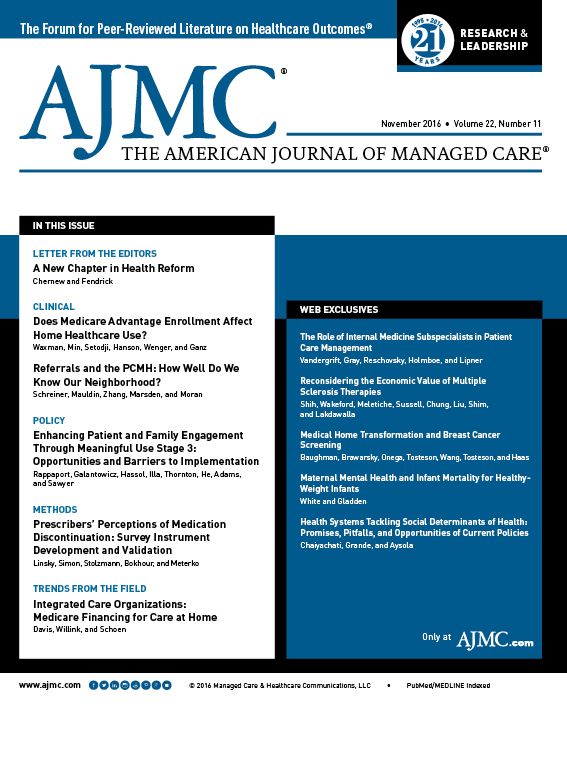- Center on Health Equity & Access
- Clinical
- Health Care Cost
- Health Care Delivery
- Insurance
- Policy
- Technology
- Value-Based Care
A New Chapter in Health Reform
Following the results of the recent presidential election, AJMC® Co-Editors-in-Chief weigh in on the implications of this new chapter in health reform.
Am J Manag Care. 2016;22(11):711The results of the recent federal and statewide elections sent a clear message that significant changes in the direction of health policy are on the horizon. Yet, the underlying maladies that diminish length and quality of our lives remain. Our healthcare delivery system, one of several key contributors to population health, suffers from considerable inefficiency. Prices are too high, transparency is too low, and incentives among stakeholders are misaligned and often are not directed to improve patient-centered outcomes. For a panoply of reasons, individuals systematically underconsume clinical services that will enhance their well-being (missed opportunities) and haphazardly use hundreds of billions of dollars in services that contribute nothing or little to their health (waste). For decades, strides have been made to increase the efficiency of our system. Since 2010, the Affordable Care Act jumpstarted these efforts in many ways, such as by expanding coverage, better engaging consumers, and changing provider incentives for providers from a volume-driven system to a more efficient and quality-driven one. As a new chapter in health reform is upon us, we would like to think that the goals of improving the experience of care, improving the health of populations, and reducing per-capita spending on healthcare are shared by all stakeholders.
There is little doubt that new strategies to achieve the Triple Aim will be implemented. Doing so will require development and respect for evidence. Greater emphasis will likely be placed on innovative benefit design (eg, Health Savings Accounts [HSAs]) and, perhaps, relatively less on payment reform. Hopefully, experiments underway to assess innovative provider- and consumer-facing initiatives will continue, and the learnings of the past 5 years will not be lost. Payment reform models have been a modest success and further evaluation of existing alternative payment models should continue to inform transformation moving forward. Transparency tools may help, but currently, they are seldom used, which suggests that we have far to go before consumer-oriented strategies reach their potential. Innovation in benefit design must also continue. High levels of consumer cost sharing should be limited to clinical services that do not produce health to the consumer and situations where patients can shop among providers. Even then, increased out-of-pocket costs can impose risk—especially on those populations that are economically vulnerable or faced with chronic clinical conditions. Specifically, given the apparent priority role of HSAs in the Trump administration’s health policy agenda, regulatory barriers must be eliminated to allow health plans the flexibility to best serve the health of enrollees.1 HSA reform has broad multi-stakeholder and (very rare) bipartisan political support.2
Michael E. Chernew, PhD, and A. Mark Fendrick, MD, Co-Editors-in-Chief, The American Journal of Managed Care®
Americans deserve to get more health for their healthcare expenditures. There are no silver bullets to these complex issues. It is our hope that The American Journal of Managed Care® will continue to play a nonpartisan role in the healthcare transformation dialogue. REFERENCES
1. HSA-eligible high-deductible health plans. Center for Value-Based Insurance Design website. http://vbidcenter.org/initiatives/hsa-high-deductible-health-plans/. Accessed November 10, 2016.
2. Bipartisan “Access to Better Care Act” introduced to House of Representatives [press release]. Washington, DC: Center for Value-Based Insurance Design; July 7, 2016. http://vbidcenter.org/press-release-bipartisan-access-to-better-care-act-introduced-to-house-of-representatives/. Accessed November 10, 2016.  

Trends in Hospital Pricing for Vulnerable Emergency Department Users, 2021-2023
December 4th 2025Self-pay emergency department prices rose significantly from 2021 to 2023, especially at for-profit and system-affiliated hospitals, highlighting growing affordability challenges for uninsured and underinsured patients.
Read More
Integrated Care for Chronic Conditions: A Randomized Care Management Trial
December 3rd 2025The authors sought to understand the differential impact of payer-led community-based care management approaches on stakeholder-oriented outcomes for publicly insured adults with multiple chronic conditions.
Read More

